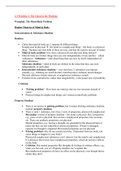2.3 Problem 2: The Ghost in the Machine
Westphal: The Mind-Body Problem
Dualist Theories of Mind & Body
Interactionism & Substance Dualism
Dualism
Claim that mind & body are 2 separate & different things.
Nonphysical & physical ‘the mind is a nonphysical thing’, ‘the body is a physical
thing’. Dualism says that both of these are true, and that the mind is not part of nature
Mind & body problem: how does a physical & non-physical thing interact?
Mind & body are distinct things that can exist independently of one another – called
‘substances’. Substance = individual thing that can exist by itself, independent of
other substances
Substance dualism = mind & body are distinct in the sense that they can exist
independently of each other
Interactionist substance dualism = view that these 2 substances can interact
causally, e.g., drinking too much alcohol, mind becomes confused, mood changes.
Physical substance (body) interacts w/nonphysical substance (mind)
Freedom from contradiction, rather than imaginability, is the proper test of possibility
Criticism
‘Pairing problem’ - How does my mind go into my tree structure instead of
yours?
Physical things & nonphysical things can’t interact (mind-body problem)
Property Dualism
There is an answer to pairing problem, but it means ditching substance dualism,
instead: property dualism
There is only 1 substance, but it has 2 sorts of properties, physical & nonphysical.
Physicalist version of property dualism = the mind is physical. Has 2 properties:
e.g., piece of art is physical, but can have nonphysical properties, like accurate,
etc. These are aesthetic properties, not physical.
Mental properties, e.g., having a thought, are grounded in the physical brain or
mind, but they are not reducible to physical properties. If brain is damaged,
capacity for thought is impaired. But mental properties are not physical
Pairing problem: why do my mental activities, if detached from my body, not
cause things to happen in your body?
Physical & nonphysical substances can’t interact, but the mind is not nonphysical,
it is physical. But it does have nonphysical properties, which do not have effects
on the body
Criticism: But mental properties like thoughts & feelings do initiate effects, e.g.,
when you feel sad, you cry. Property dualism can’t explain this
So: nonphysical properties do have an effect on the physical, even though theory
claims they don’t
, Parallelism
Mind & body are separate (physical vs. nonphysical), but don’t interact, bc physical &
nonphysical can’t interact
Parallelism says that there is no interaction between mind & body, there is a
correlation between what happens in the body and what happens in the mind wherever
we thought there was an interaction, e.g., drinking of alcohol is followed by foggy
mind – it is correlated w/it
Dualism suggests that mind & body interact, but mind & body are really just
synchronized. Causal interaction = synchronization
When one clock strikes 3, so does the other. If there is slight time lag, might say that
first clock makes second clock strike. This is a false inference = post hoc ergo
propter hoc (after this therefore because of this)
Criticism:
Occasionalism parallelism is true, but physical events in the body are the occasion
for God to act in the mind, and vice versa
Preestablished harmony
God gives you the materials to work with, then leaves
The Role of the Conservation Laws
Mind & body are separate, have their own energies, own mass, can’t influence each
other
Conservation of mass & energy tells us that in a ‘closed’ system changing over time,
the net total of mass/energy in the system stays the same. The system as a whole
neither gains nor loses mass or energy (there are particles with no mass, but they must
have some energy, since energy is a function of frequency)
Human body = closed physical system
It acts as it does because of the physical energy & mass that it contains, and it is
insulated from the effects of outside energy. This has been called ‘the causal closure
of the physical’. If we want to change anything within the system, we will either have
to use the energy that is already within the system, or we will have to introduce
energy from the outside. If we use the energy in the system, then the mind, since it is
not within the body, can have no effect on the body. If we do not use the energy
already in the system, than mass & energy are not conserved, or the system is not
closed
However, if the mind is to effect a change in the body, then it must presumably
introduce physical energy into the body. But the mind is nonphysical, so it can’t do
that.
The body will not accept nonphysical energy, and the mind will not accept physical
energy
Conclusion: we should be either parallelists or physicalists (everything that exists is
physical, so mind is physical thing, if it is a thing), but not interactionists
Epiphenomenalism, Emergentism and Supervenience




